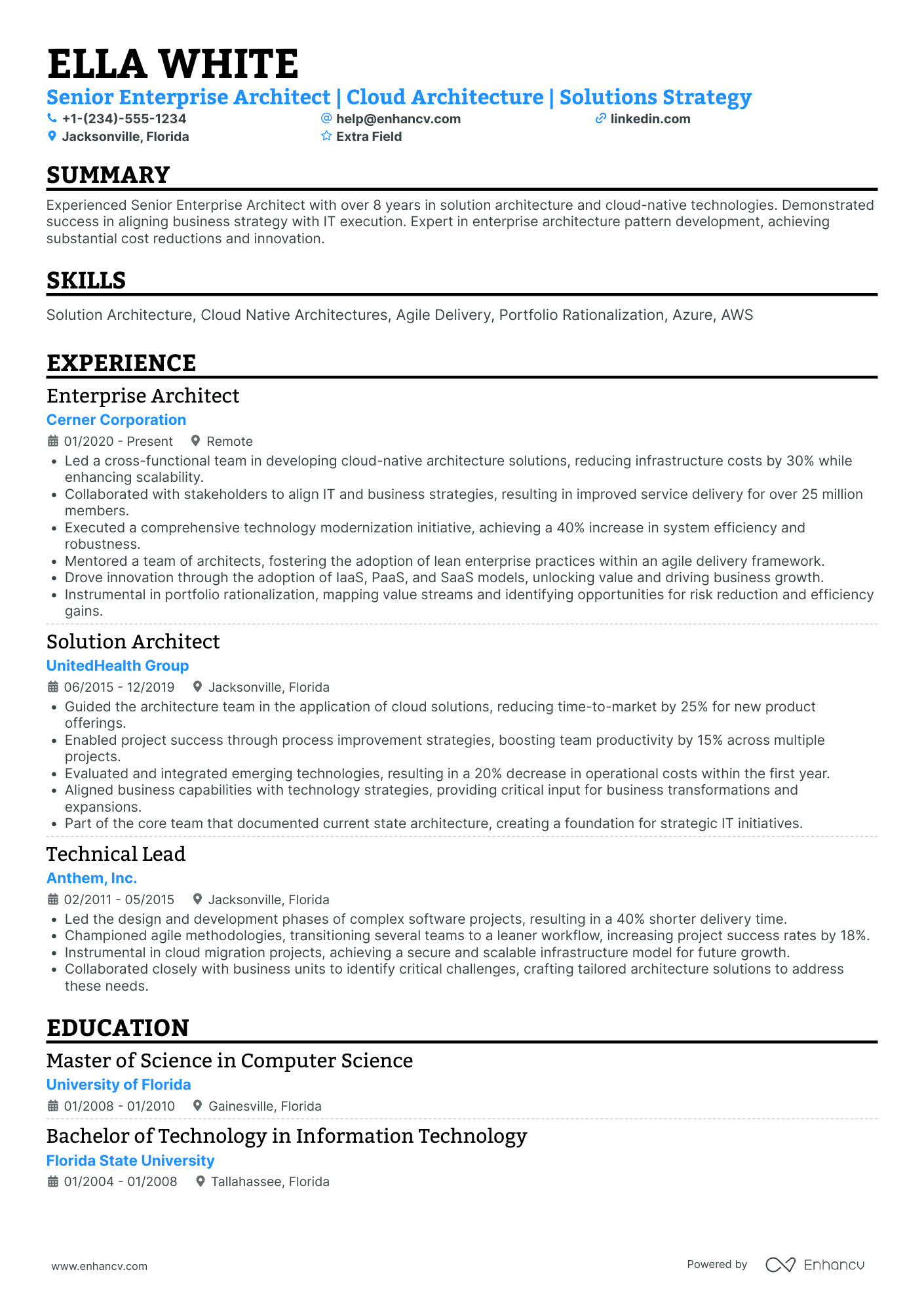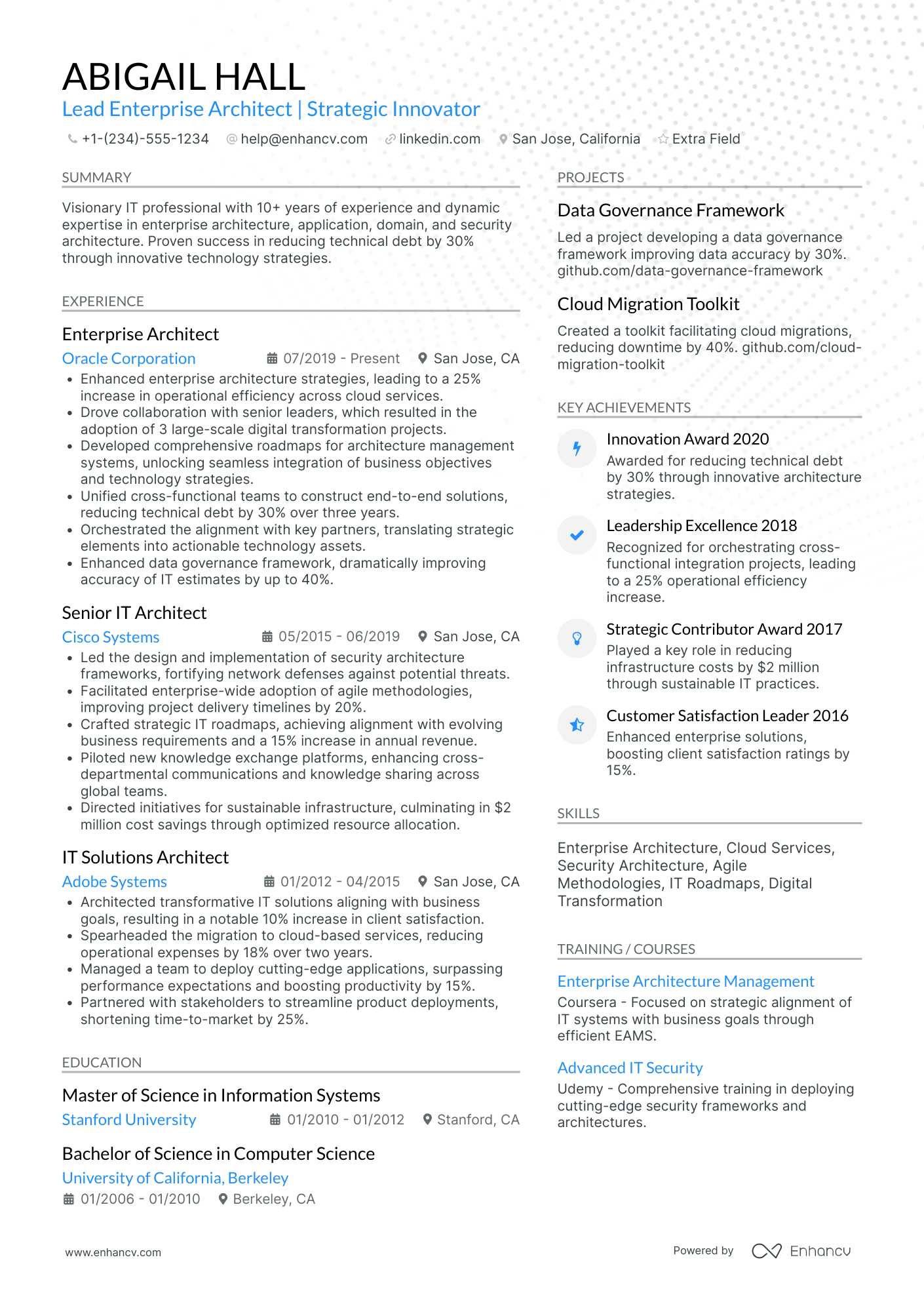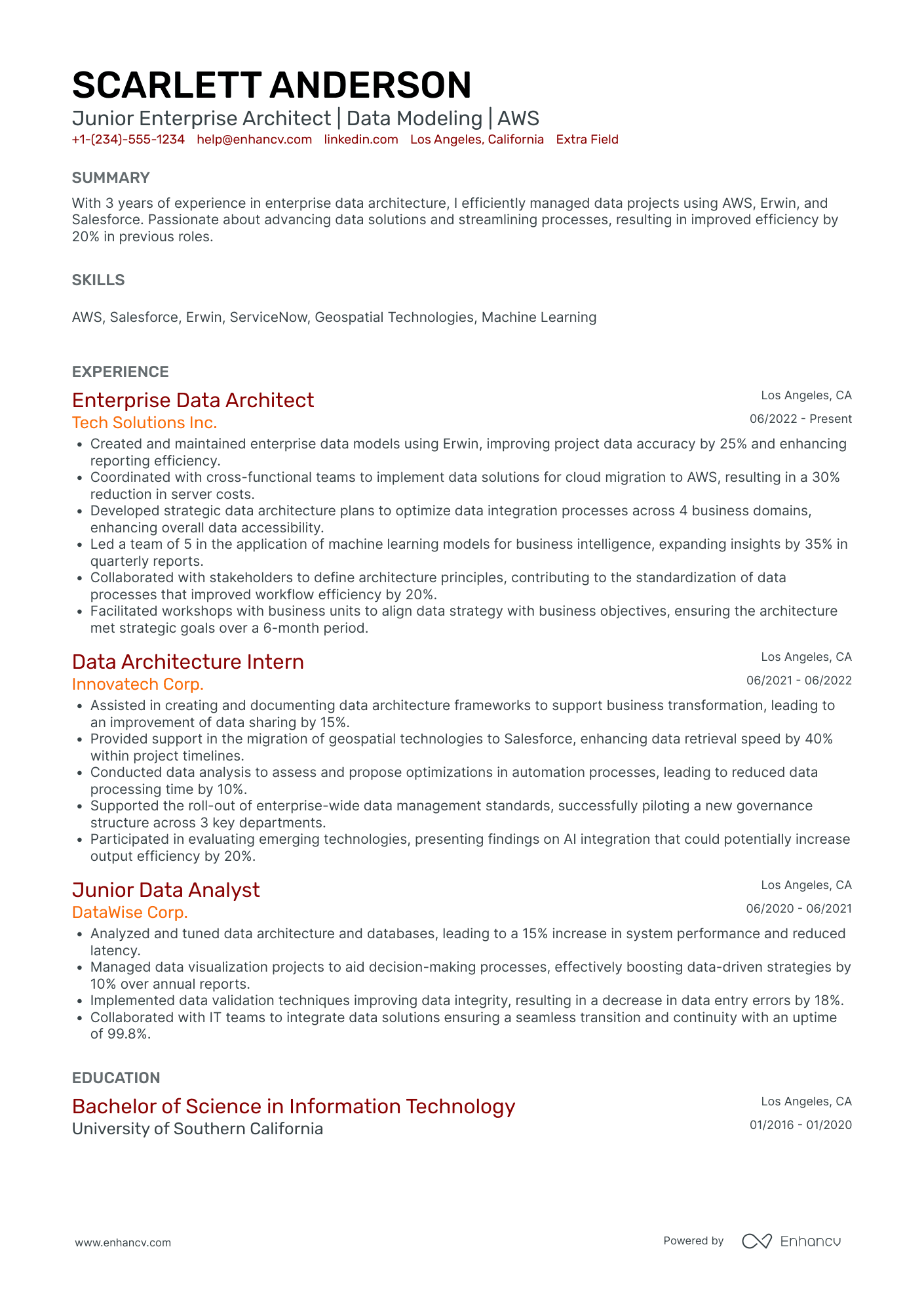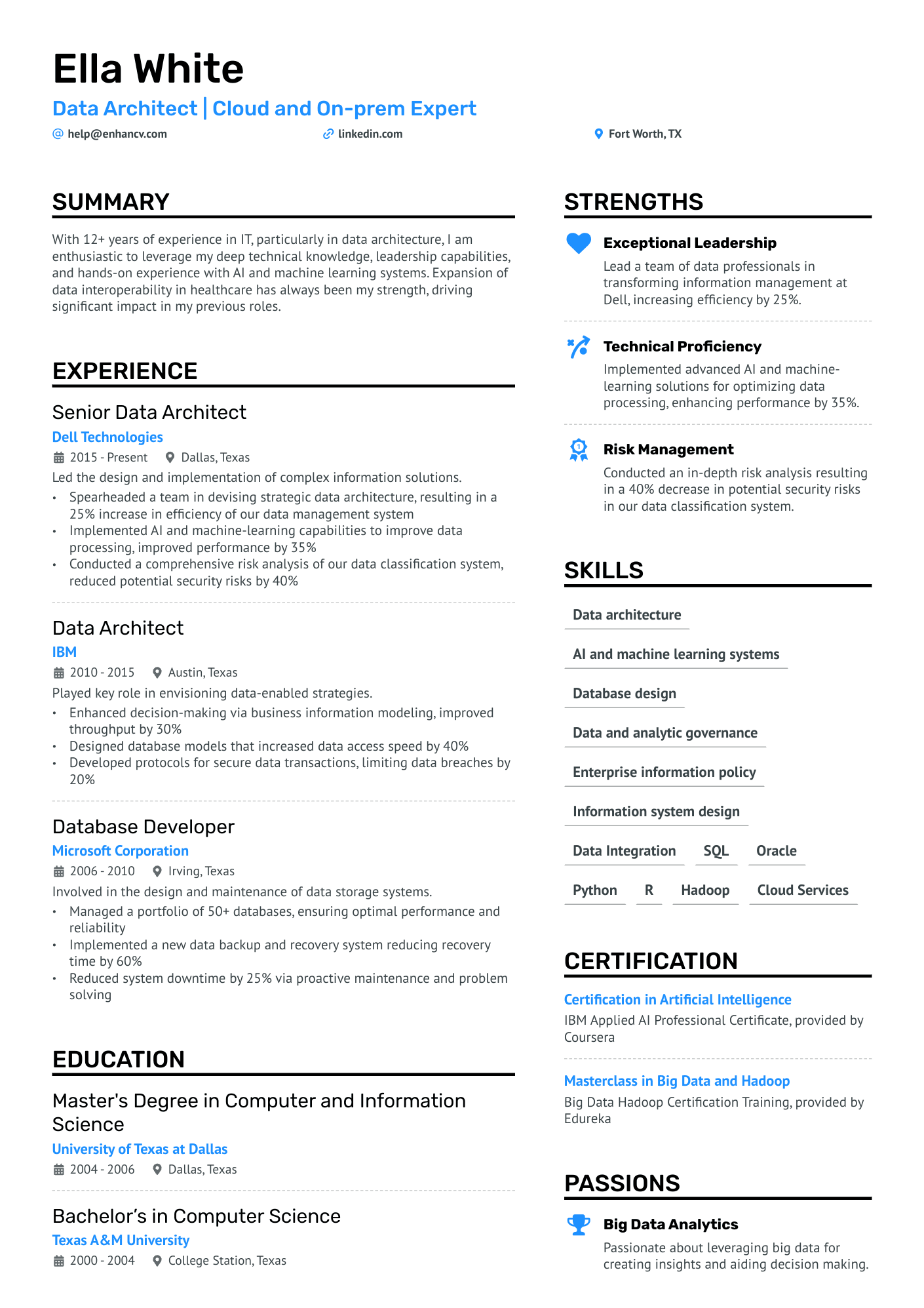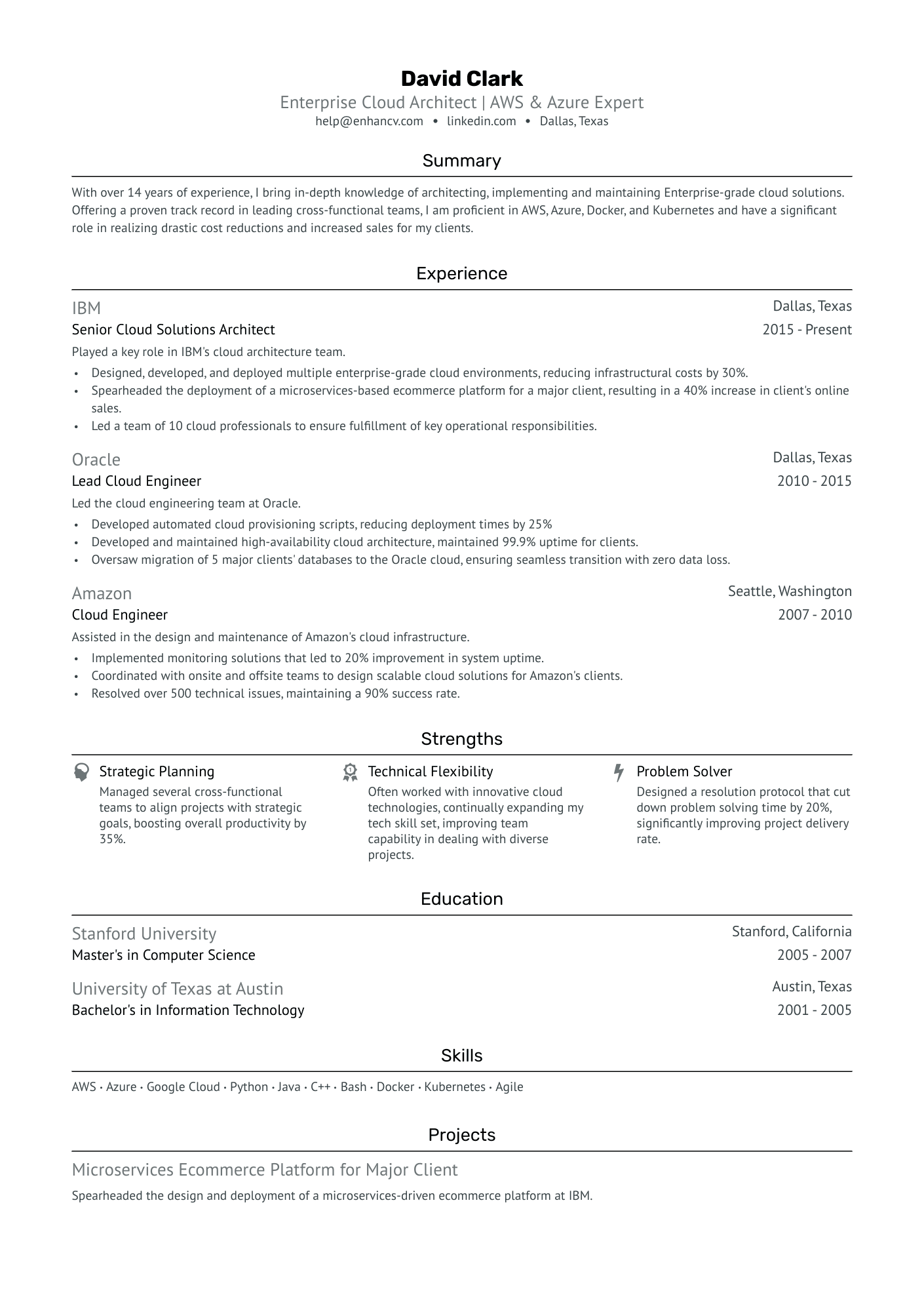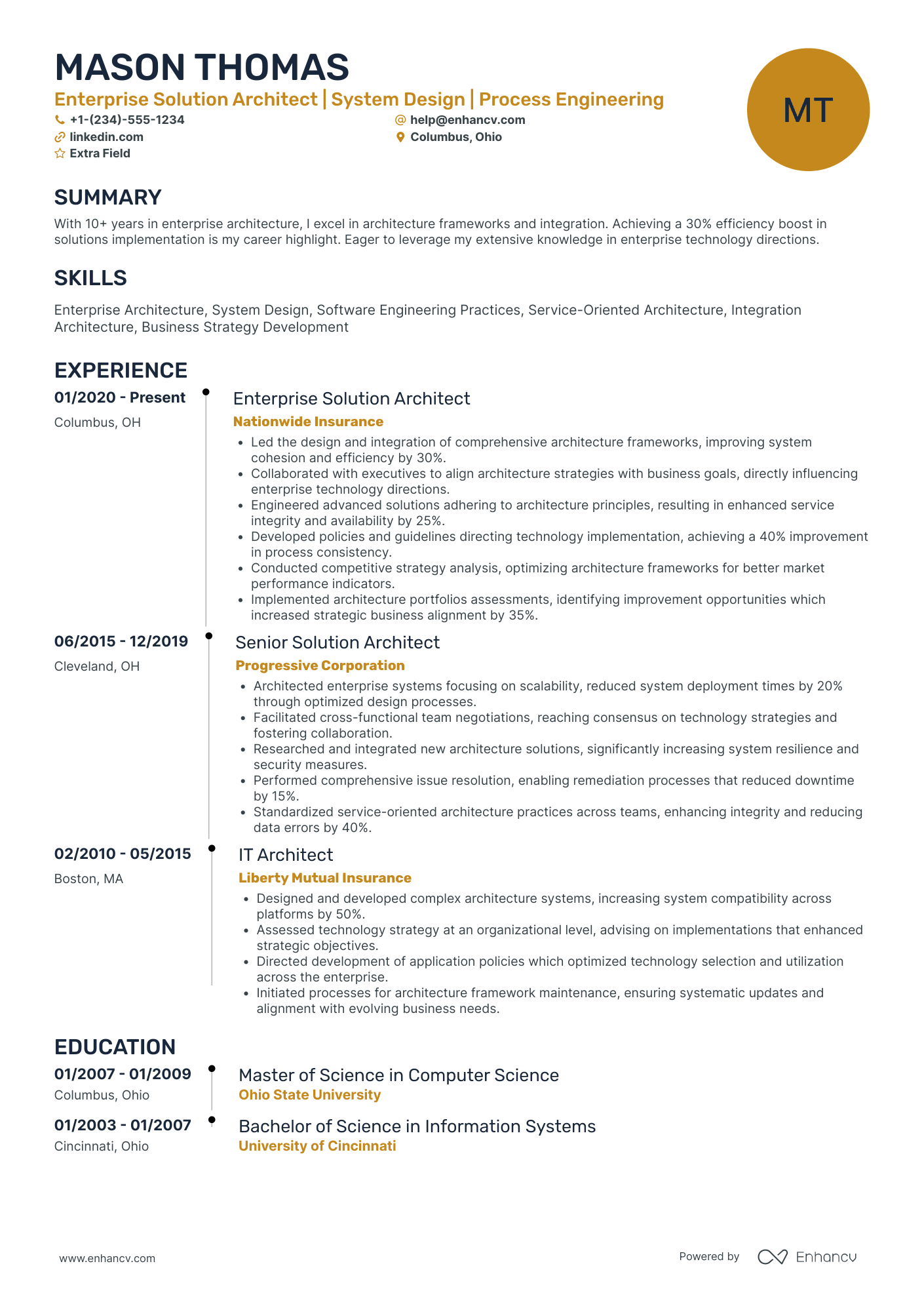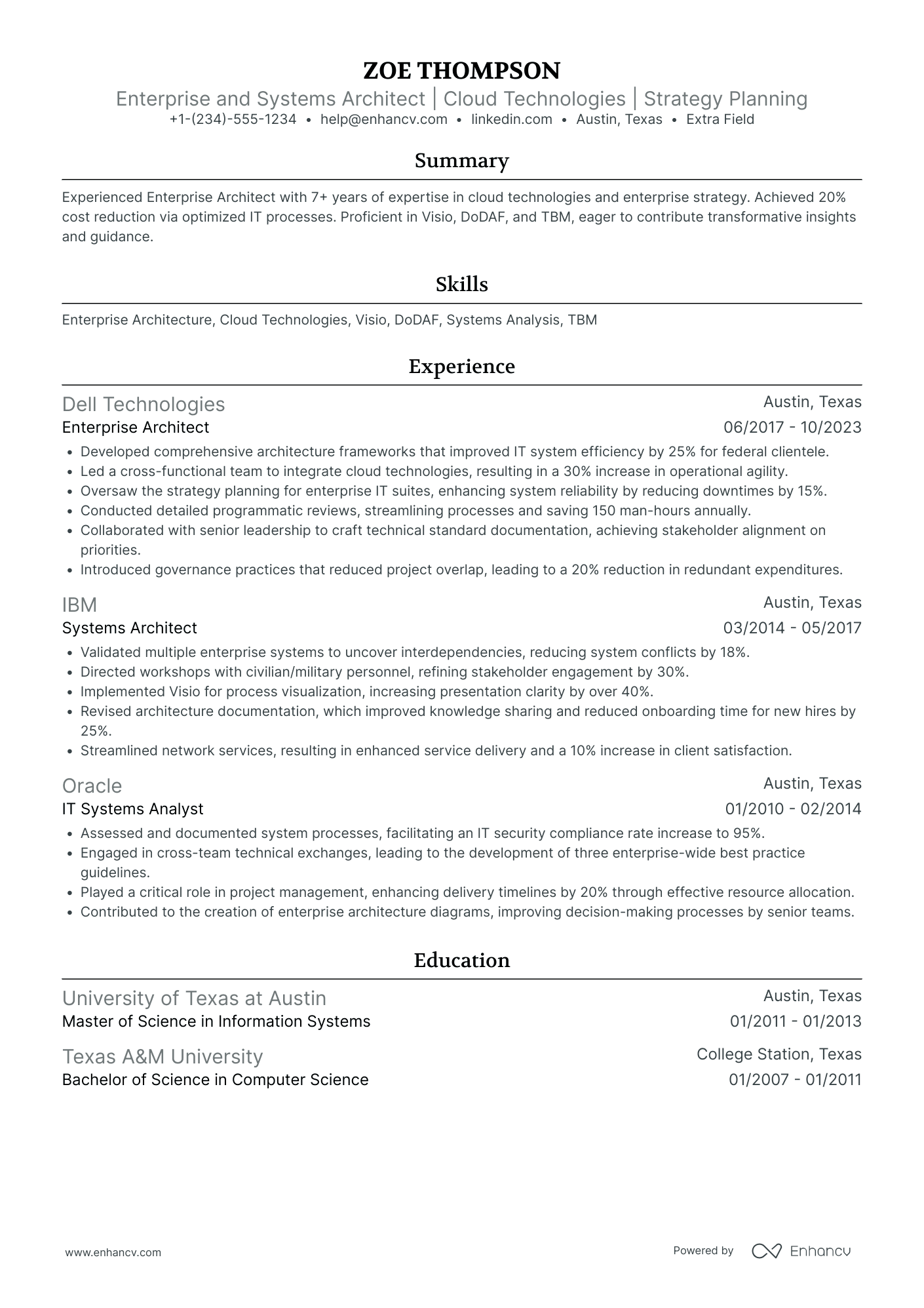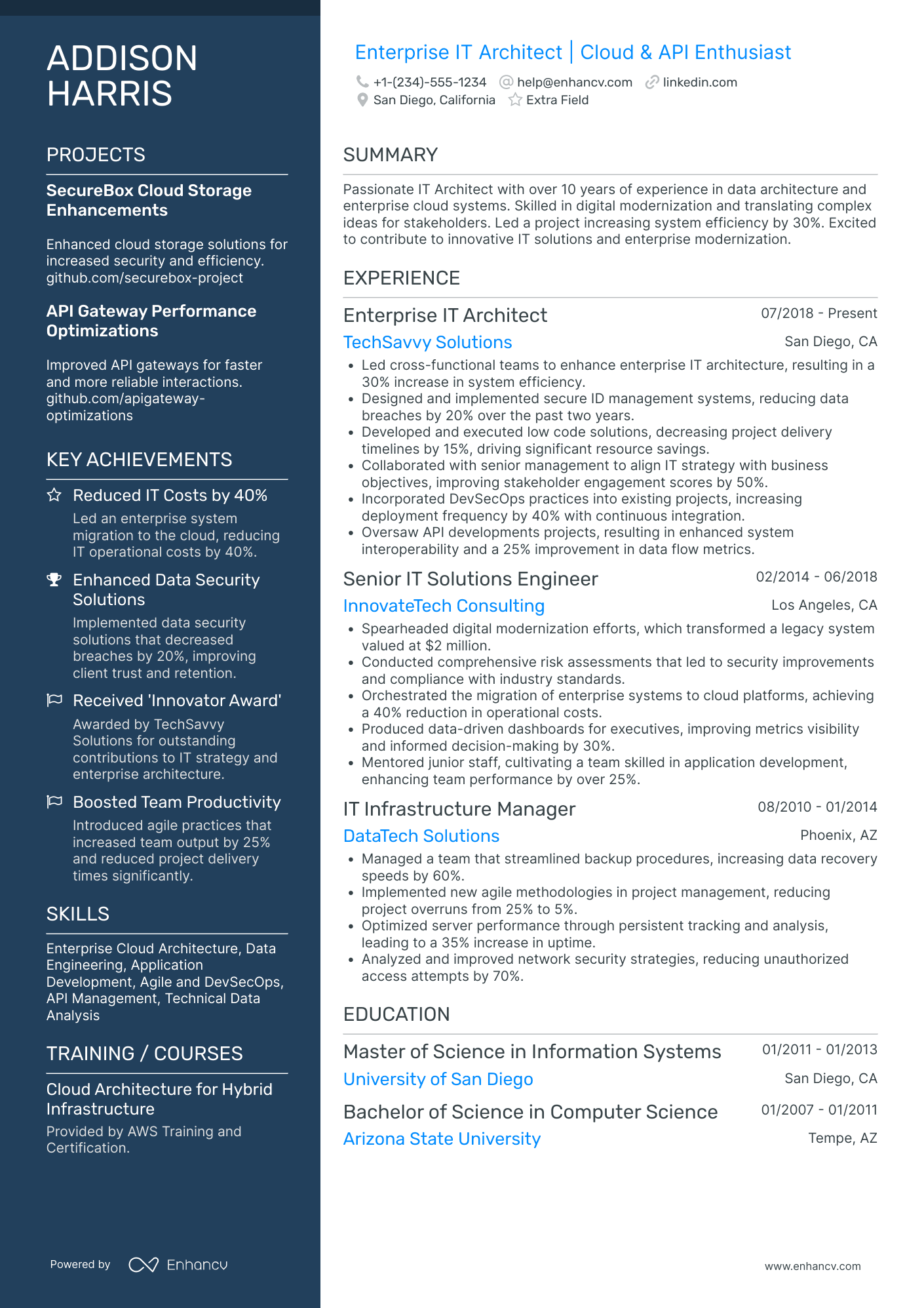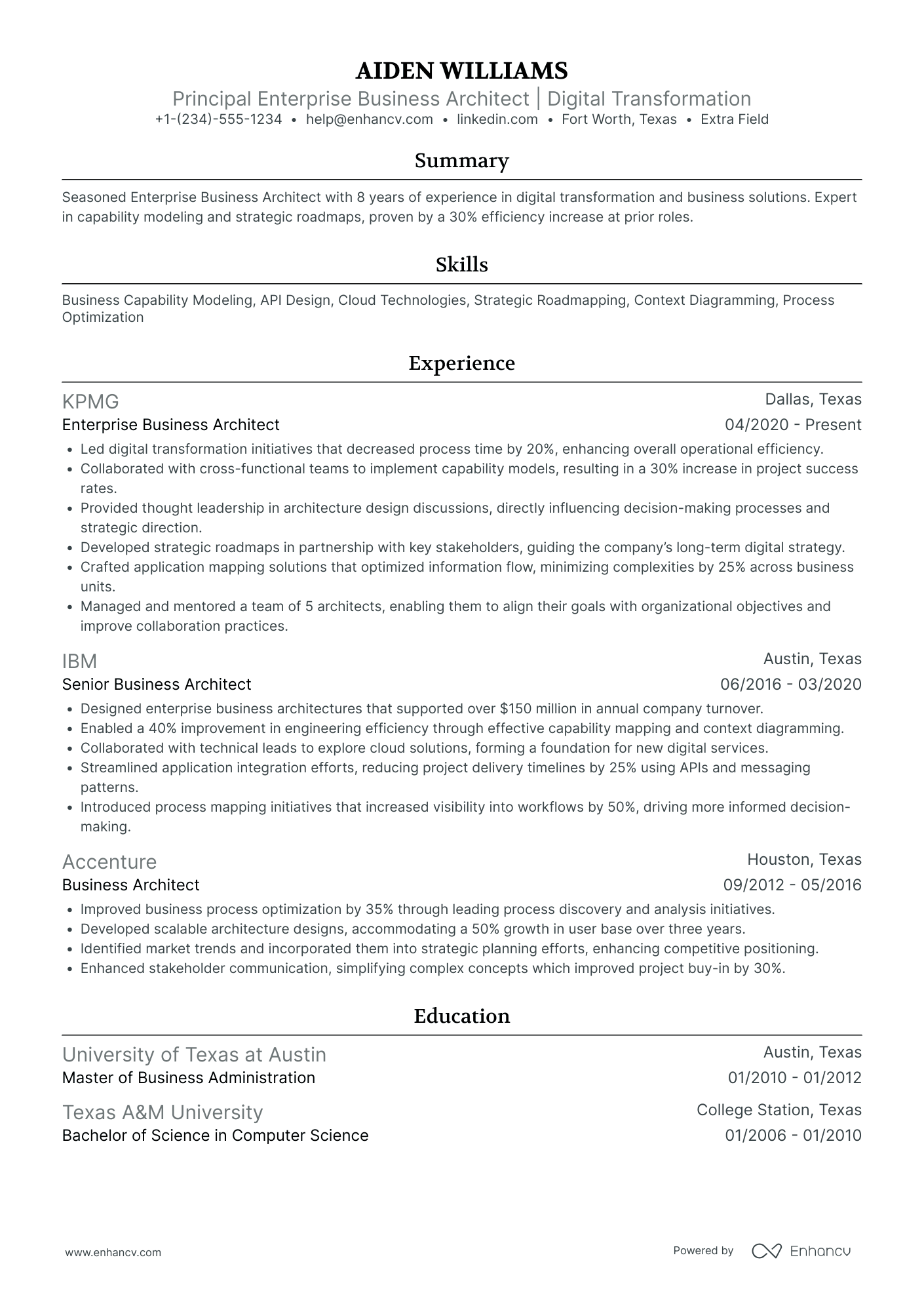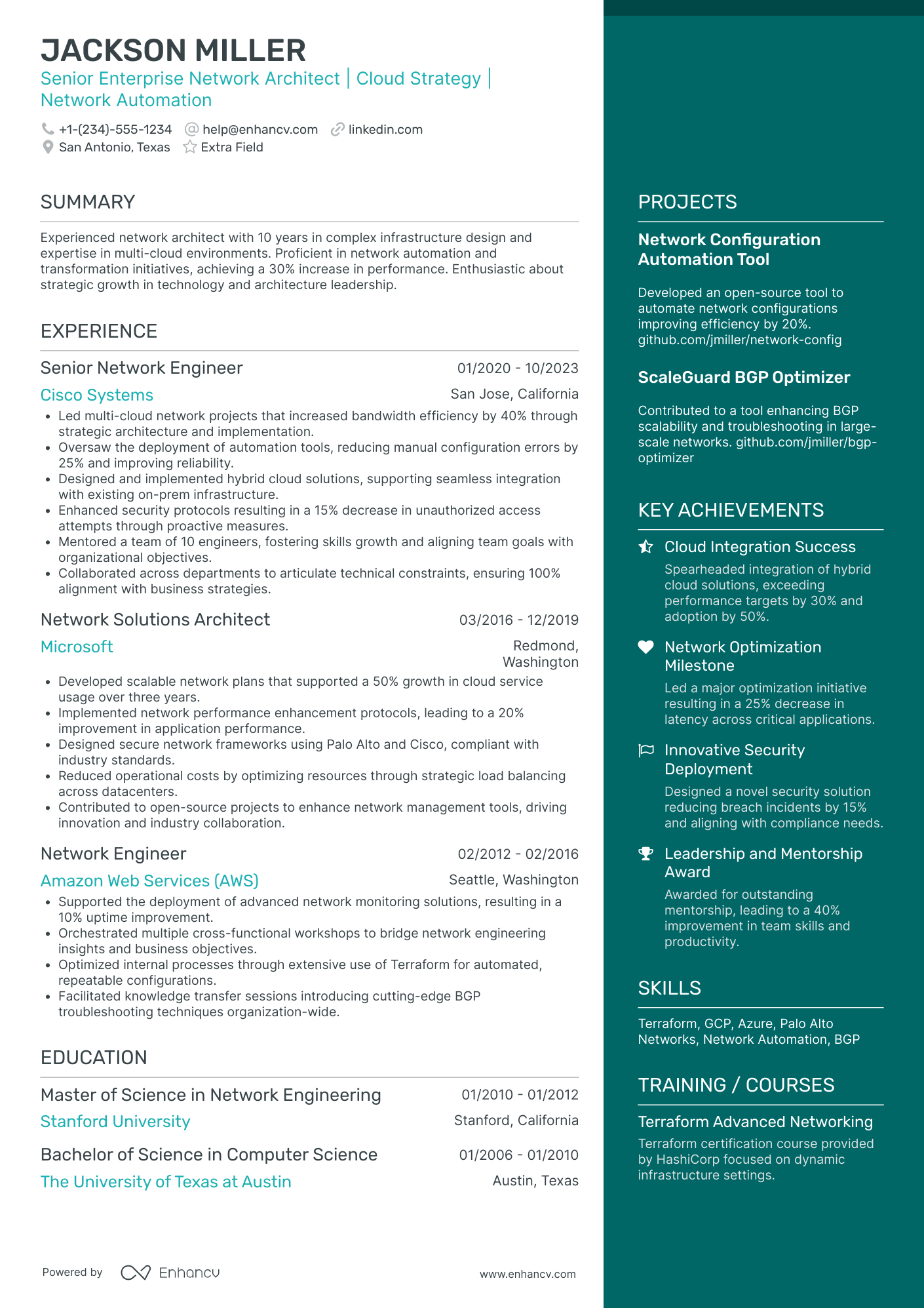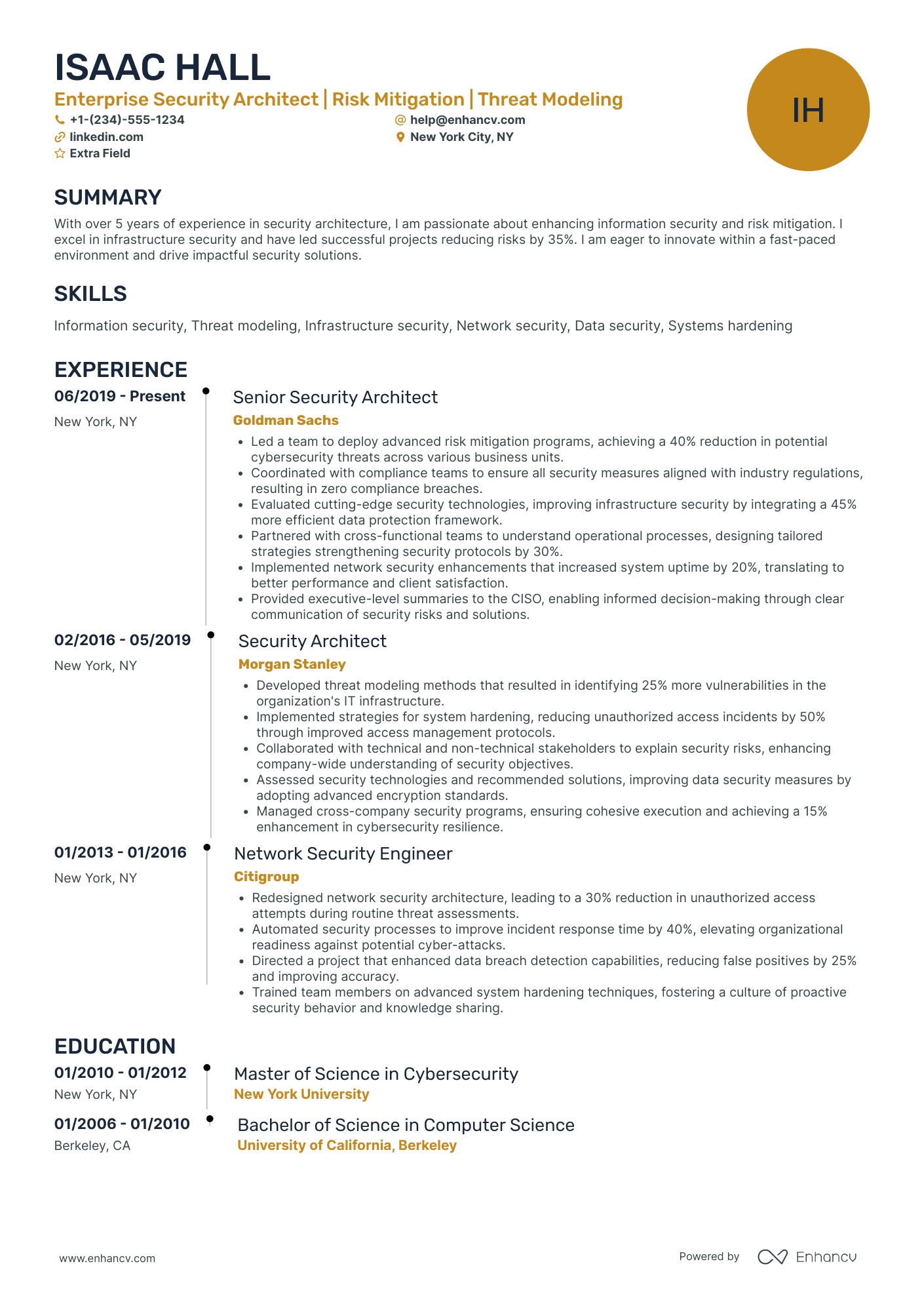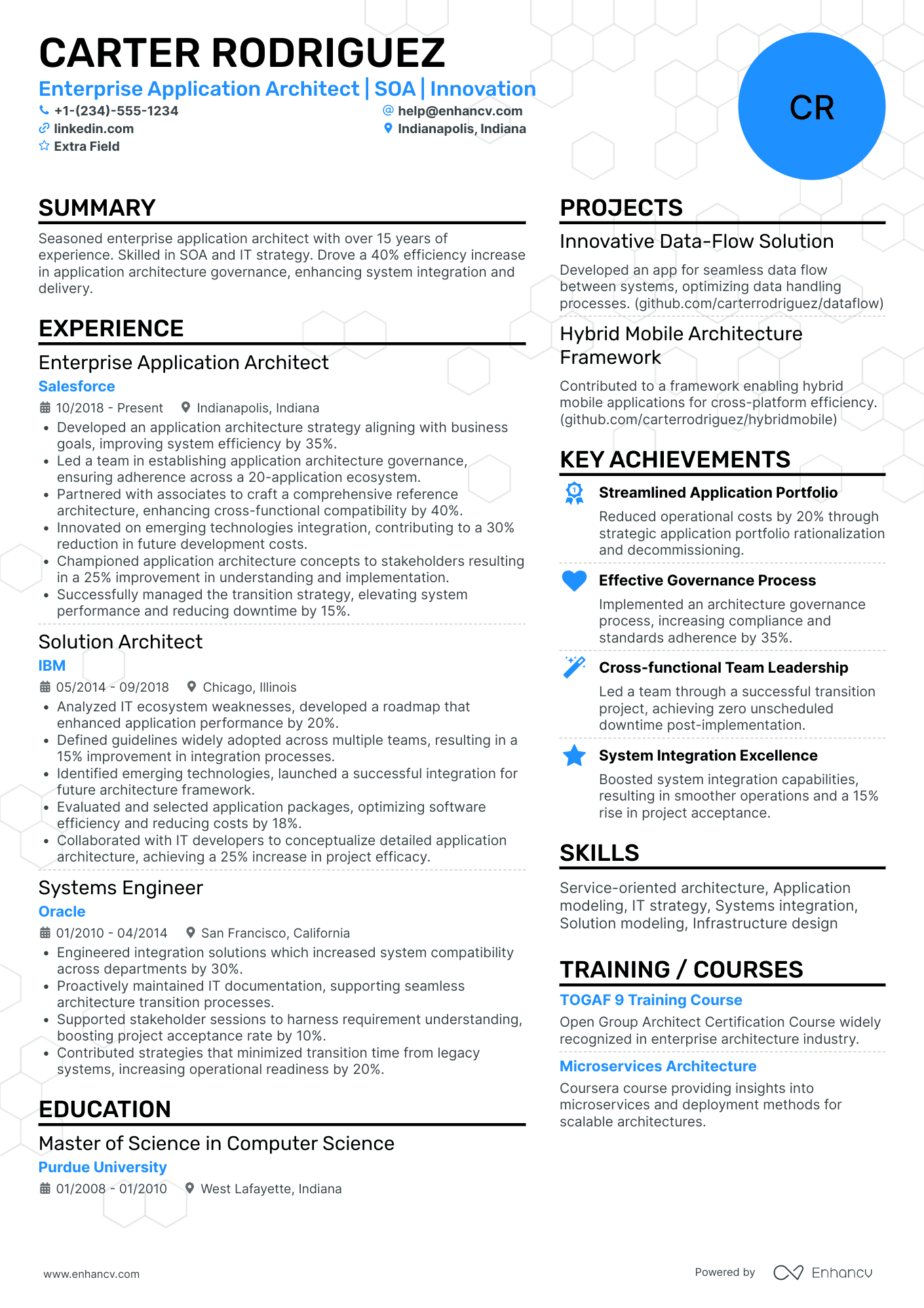Striking a balance between your technical skills and business acumen on your enterprise architect resume can be a nightmare.
Not to mention proving you have the social talents to foster relationships with stakeholders and developers alike.
Follow our guide to:
- Learn how and when to showcase various aspects of your work
- Review real enterprise architect resume examples and get ideas on how to frame yours
- Build a solid skills section that reflects both your tech and social talents
Afterwards, you can browse through the related examples below to gain a better understanding of the differences between this and similar positions:
Enterprise Architect resume examples
By Experience
By Role
How to format your enterprise architect resume
You know that no matter who you’re consulting, phrasing your explanations the right way is key to being understood.
Even if you’re just starting as an enterprise architect, you know that your job involves talking to both IT professionals and non-techies.
You have to treat your resume the same way. In most cases, your application will be reviewed by a hiring manager before it reaches the desk of the technical team leader.
So you must be very clear in how you’re going to structure your resume and layout your work experience. For the best results:
- Pick the reverse-chronological resume format: Showcase your past positions from newest to oldest. But keep it relevant and don’t go back further than 10 years.
- Use the resume header to point to your LinkedIn and your Github: You have to appeal to both recruiters and IT specialists. Make sure you grab their attention right from the beginning.
- Emphasize your special credentials at the top of your resume: Depending on the role type, there may be additional job requirements. If you have a security clearance, remember to list it in the resume summary.
- Stick to the job ad’s phrasing and use of keywords: To optimize your resume for any ATS (Applicant Tracking System) tests, it’s best to speak your potential employer’s language.
- Don’t worry if your resume spans more than one page: You're fine as long as it doesn’t go beyond two pages. However, be mindful of hiring managers’ limited time to review applications. Don’t add unnecessary information.
- Select a readable font: Lato and Raleway are perfect for your enterprise architect resume, if you don’t want to use a generic font. But other serifs and sans-serif fonts work just as well.
- Preserve the design of your resume: The best way to do this is to save your application as a PDF file. Ensure recruiters see your enterprise architect resume the way you intended for it to be seen.
Based on the requirements for your desired role, you may need to push certain resume sections near the top.
For example, if the position falls primarily under the AO (Architecture Owner) category, then highlighting your hard skills is a must.
One way to showcase your technical prowess is to use a two-column resume layout. Place the talent section and your certificates at the top of any of the two columns.
By contrast, senior enterprise architects must draw attention to their team leadership and stakeholder management skills.
To do this, don’t forget to mention relevant memberships in professional associations or conference presentations you’ve done.
Consider the local standards – Canadian resumes, for example, may have a different format.
Is your resume good enough?
Drop your resume here or choose a file. PDF & DOCX only. Max 2MB file size.
Whichever details you choose to feature first, remember to leave space for all the essential resume sections:
The top sections on an enterprise architect resume:
- Professional summary: Offer a concise overview of your career history, skills, and pertinent knowledge so that recruiters get a good snapshot of your capabilities.
- Core competencies: Enumerate your key enterprise architecture skills and abilities to allow hiring managers to identify your strengths quickly.
- Experience and job history: Showcase how your career has progressed so far by highlighting relevant past roles and sharing notable achievements.
- Education and certifications: Detail your academic qualifications and any pertinent certifications to boost your credibility and demonstrate your commitment to professional advancement in this field.
- Technical proficiencies: Display your familiarity with all the platforms, architectural software, and tools referenced in the job ad. Prove to hiring managers you possess the required technical skills.
What recruiters want to see on your resume:
- Proficiency in architectural frameworks: Recruiters prioritize this to ensure the candidate can work with methods like TOGAF, which are crucial in planning and designing IT architecture.
- Experience with multiple coding languages: enterprise architects must be able to understand and coordinate between teams that may be using different technologies.
- Leadership skills: Being able to manage teams and effectively communicate architectural plans and designs are essential abilities for the role.
- Knowledge of business processes: Effective enterprise architects have a solid grasp of business processes as all IT systems and operations must be aligned with the company’s goals.
- Project management skills: Recruiters look for candidates who can efficiently lead and manage large-scale architecture projects from inception to completion.
How to write your enterprise architect resume experience
The resume experience section is where you:
- Outline your work history
- Share your top accomplishments for the listed positions
- Showcase diverse aspects of your work
Each of the bullet points in your experience entries must reflect your job duties without explicitly stating what they were.
Many of the resumes we review include a laundry list of responsibilities. But these mean nothing on their own. Context and results are more important to employers.
Remember, the focus of your resume must be on career progression, skills, and achievements.
For a detailed view of which methodologies you use or specific structures you’ve built, recruiters will refer to your GitHub or your portfolio.
Also, we’ve already mentioned how different companies have different needs. As a result, an enterprise architect’s duties can vary greatly from one position to another.
On top of that, you have to keep in mind that recruiters don’t have much time to spend on individual resumes.
All this means you must strategically arrange your achievements for every position you’ve included in your work history section.
So, to guarantee hiring managers spot your most relevant work:
- Read the job description carefully.
- Consider whether the role is predominantly a managerial one or a technical one.
- Pick a top achievement that best aligns with the type of role offered.
- List it as your first bullet point for the particular experience entry.
But if the company prefers a well-balanced professional with equal enterprise architect expertise in:
- IT infrastructures, frameworks, network administration, applications, and tools
- Business operations, competitors, and market fluctuations
- Leadership skills, relationship, and project management…
Then you can be a bit formulaic in your writing approach.
Generally, each entry should include between three and five bullet points. Use the opportunity to match each bullet point to a specific aspect of your work.
That way, even if you have only three bullet points, you provide a balanced overview of the scope of your abilities.
Finally, to impress recruiters begin each bullet point with a resume action verb. These will strengthen your application by emphasizing all the right places.
Now, have a look at the following enterprise architect experience section sample:
- •Boosted YoY revenue for 2022 readjusting parts of the current IT structure.
- •Built 5+ business capability maps.
- •Reduced maintenance and subscription costs.
The applicant has tried to elevate their resume by using action verbs, but there are quite a few issues here:
- The job title is abbreviated. While a technical team leader might understand what the candidate means, hiring managers probably won’t.
- The applicant states they have been a Junior Architecture Owner for three years. Since recruiters want to see a clear career progression, being stuck at an entry-level position for such a long time doesn’t look good.
- Most of the listed achievements include some kind of metrics. However, the context to describe the scope of the candidate’s work is missing.
Here is how much of an impact these mistakes can have on the overall presentation of your experience:
- •Boosted YoY revenue for 2022 by $37 million by readjusting and aligning parts of the current IT structure with MaXIT's overarching business objectives.
- •Built 5+ business capability maps for several commercial real estate clients who needed a complete overhaul of their existing IT infrastructure, thus saving a total of $20 billion in expenses.
- •Reduced maintenance and subscription costs by $2.4 million for 2021, as a result of decommissioning more than 14 legacy applications and solutions.
Outstanding!
This version offers a comprehensive summary of what the applicant did and the results they’ve achieved.
Moreover, now the information in the entries completely aligns with the listed job title.
Plus, the candidate has some impressive achievements to prove just how beneficial their work can be for potential employers.
How to quantify the impact on your resume
Starting your bullet points with an action verb is only half of what makes an impressive experience entry.
You’ve probably heard the saying that actions speak louder than words. When it comes to resumes, data speaks louder than any resume buzzword you attach to your achievements.
This means that whenever you talk about your career accomplishments you must quantify the outcome of your work. Whenever possible, tie your achievements to concrete numbers.
If you’re not sure which metrics hiring managers take into account, take a look at the suggestions below:
- Number of technology projects you’ve led: Demonstrate your experience and success in similar roles.
- Number of teams or members you’ve managed: Indicate your leadership and team management capabilities.
- Amount of financial savings achieved: Detail your ability to reduce costs or save money through the implementation of efficient technical solutions. Express them as a percentage or in dollars.
- Number of architectural frameworks you’re proficient in: Showcase your versatility and breadth of knowledge in the field.
- Number of business processes you’ve improved through new IT architectures: Display your ability to elicit positive operational changes.
- Size of the projects you’ve worked on: Describe the scale of the tasks and operations you’ve handled.
- Number of years of experience in the industry: Emphasize the depth of your enterprise architecture knowledge and experience.
- Percentage of efficiency increase or downtime reduction achieved through your solutions: Indicate the impact of your work through the efficiency of your work approach.
How do I write an enterprise architect resume with no experience
Not having been employed as an enterprise architect doesn’t mean you don’t have the relevant knowledge and expertise for the job.
Whether you’re a novice or switching careers, you can still build a powerful resume. All you have to do is be mindful of which of your experiences relate most to the available role.
To do this:
- Review the job requirements again.
- Evaluate whether the role demands a more hands-on technical approach or if it’s more business-oriented.
- Think of past positions from which you’ve gathered invaluable industry insights or relevant skills for the job.
- Frame your expertise in a way that will resonate with the responsibilities and goals of the offered role.
- Provide context and quantify your achievements before you add them as part of your work history.
How to list your hard skills and soft skills on your resume
Typically, the skills section on your resume provides a proportionate overview of your core skills and strengths.
Part of the section should cover your enterprise architect hard skills. These include your proficiency in the TOGAF and Zachman frameworks.
As well as expertise in IT Infrastructure planning and UML among other abilities.
Another portion of the talent section should tackle your soft skills. These represent your ability to:
- Present your ideas and explain complex concepts
- Work cross-functionally and across different verticals
- Manage stakeholder expectations, while guiding tech teams on current business priorities.
However, given the complexity of the role, you’ll have to draw attention to certain types of abilities more than others. It all depends on the job description and what you have to offer.
Regardless of which talents you choose to describe, make sure you quantify your achievements:
- Share certifications and recognitions you’ve received.
- Talk about the presentations you’ve given.
- Mention relevant projects you’ve led and how your work has contributed towards achieving the desired results.
We know that sometimes it’s hard to come up with ideas on your own. That’s why, we’ve compiled two lists with the most popular enterprise architect skills currently in demand:
Best hard skills for your enterprise architect resume
- Enterprise architecture design
- TOGAF
- Zachman Framework
- SOA Architecture
- Enterprise software integration
- Data modeling
- Proficiency in UML
- Business process management
- System Integration
- IT Governance
- IT Strategy
- Cloud Application Architecture
- Knowledge of programming languages like Java, .Net, Python
- IT Infrastructure Planning
- Enterprise Resource Planning (ERP)
- SDLC process
- IT Service Management
- DevOps principles
- Business Intelligence tools
- Knowledge of database systems like SQL, Oracle
- Familiarity with cybersecurity standards and frameworks
Best soft skills for your enterprise architect resume
- Communication skills
- Leadership abilities
- Strategic thinking
- Problem-solving skills
- Decision-making abilities
- Negotiation skills
- Teamwork and collaboration
- Project management skills
- Adaptability
- Attention to detail
- Relationship building
- Time management
- Analytical thinking
- Customer service orientation
- Creativity
- Initiative
- Critical thinking
- Stress tolerance
- Professionalism
- Business acumen
How to list your certifications and education on your resume
Speaking of certifications and peer recognition, your academic background is important.
Hiring managers want to confirm you have a deep understanding of IT fundamentals before they call you for an interview.
That’s because most employers request candidates to have at least a Bachelor’s degree in Computer Science or Information Technology.
But if you don’t have such credentials, don’t worry. Some companies allow for candidates to apply as long as they can prove they have degree-equivalent experience in the field.
If you’re a tenured professional with the necessary academic background, limit your education section to your Master’s and Bachelor’s degrees. For each entry:
- State the name of your degree.
- Name the accrediting institution (university, college, institute, etc.).
- List the date you completed the course.
- Reference at least one academic accomplishment.
In contrast, if your educational background is not IT-related, you’ll have to provide more information about where your strengths lie. So, when listing your qualifications:
- Cite relevant majors and minors you’ve studied.
- MBA courses or a related degree you’ve completed.
- One or two of your top academic achievements.
To illustrate:
- •Majored in Agile methodologies and Cloud Technologies.
Let’s not forget about listing certificates on your resume!
They are a good way of confirming you’re not rusty when it comes to methodologies and frameworks.
Prove to hiring managers you always keep up-to-date with industry developments. And seek ways to hone your skills.
To include your certificates, all you have to do is list the name of your qualifications and the accrediting institution.
Like so:
Best certifications for your enterprise architect resume
How to write your enterprise architect resume summary or objective
One of the few direct ways to appeal to recruiters and employers is by compiling a convincing resume profile.
This is a short synopsis of your credentials, accomplishments, and career highlights.
There are two kinds of resume profiles. To determine which one suits your needs best, you must evaluate your level of industry expertise.
The first type is the resume summary. This one is perfect for tenured professionals who have the luxury of cherry-picking which achievements they want to feature.
To build a powerful resume summary:
- Reference at least one or two of your proudest professional achievements.
- Cite some of your top technical skills and social abilities.
- Name notable employers you’ve worked for.
- Mention relevant certificates you’ve obtained.
On the other hand, if you’re switching careers or don’t have much practical experience, write a compelling resume objective.
This type will allow you to showcase relevant achievements and transferable skills. Make sure to emphasize how your expertise and experience will benefit potential employers.
Align your application with the company’s core mission and business goals. Just like you would do with its IT infrastructure.
Let’s look at a few examples to give you a better idea of the main difference between the summary and the objective.
First, we have the enterprise architect resume objective of an IT graduate:
This applicant won’t get noticed by hiring managers because they haven’t:
- Mentioned any prior experience, such as internships or work on relevant projects.
- Detailed any achievements to prove how beneficial their skills can be.
- Shared any credentials to verify their professional qualifications.
Once the candidate addressed these issues per our advice, here is how their resume objective transformed:
Despite their limited experience, the applicant has effectively quantified their achievements. The objective also:
- Outlines the candidate’s strengths without relying on resume buzzwords to do the job.
- Indicates the individual has an important clearance status that may be pertinent for the position. Particularly if they conduct business with government entities.
- Cites specific certifications the applicant has acquired to grow their toolkit.
Next, have a look at the following enterprise erchitect resume summary:
Many professionals struggle to sum up their expertise in one small paragraph. Some even draw a blank when you ask them to choose one top accomplishment they want to feature.
In this case, the applicant has:
- Stated they’ve been in the industry for the past seven years. Yet, there is not enough evidence to support their claims.
- Not named any specific certificates to verify their skills are up-to-date with current industry trends.
- Declared being employed by multiple successful startups, but they haven’t named any companies.
It’s always helpful to describe which business niches you’re knowledgeable about. Also, be concrete about the impact of your work.
Here is how to turn the above paragraph into an eye-catching resume summary:
Now potential employers can be confident that the candidate has the experience and expertise to scale their business successfully!
Optimize your resume summary and objective for ATS
Drop your resume here or choose a file.
PDF & DOCX only. Max 2MB file size.
Additional sections for an enterprise architect resume
A good way to support your application is to include a few customized sections in addition to the essential ones.
This is a good way to stand out among other candidates. Especially, if you have some extra real estate on your resume. Or, you think your resume is missing something.
The type of sections you can attach hinges on:
- The information you’ve already covered on your resume
- The requirements of the enterprise architecture position you’re aiming for
If you’re still not sure what to add, here are some ideas to consider:
- Reference designs and prototypes you’ve presented at conferences.
- Detail human and computer languages you’re proficient in.
- Share documentation and white papers you’ve written.
- Cite a security clearance status you’ve obtained.
- Boast about relevant awards and prizes you’ve won.
- List professional associations you’re a member of.
How to put a presentation section on your resume
Featuring a presentation on your resume is the quickest way to provide a snapshot of your work style. Even if you’re a college grad who has yet to establish themselves as an expert.
To do this, simply:
- State the name of your presentation.
- Credit yourself as the author.
- Describe the purpose of your work.
- Date your presentation.
- Link to a publicly available version of the document.
This is how your extra section should look like:
- •The presentation focuses on how to translate your business objectives into a working framework for your corporate IT infrastructure, as well as how to manage the subsequent architecture development process.
Key takeaways
In short, to build a powerful enterprise architect resume, you must:
- Understand the company’s goals and specific job demands.
- Decide on what types of experience and expertise you want to share.
- Choose the reverse-chronological resume format to outline your work history.
- Provide links to your GitHub and LinkedIn in the resume header.
- Craft a convincing resume summary by including at least one career achievement.
- Begin each experience entry by listing your most pertinent accomplishments.
- Show you’re willing to develop and improve your skills by detailing your education and certifications.
